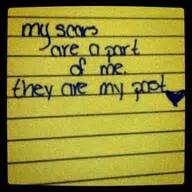It hurts me to admit that Self- Injury is on the rise in our student population. For those of you who are unfamiliar with the term, Self- Injury is :
- Done to oneself and by oneself. If someone else does it to you, it’s not self-injury.1
- Physically violent. Abusing oneself emotionally is not good, and it’s something that many self-injurers do, but by itself, it’s not self-injury.
- Intentional, or done on purpose. If it’s an accident—whether clumsiness, a mistake, or just being in the wrong place at the wrong time—if you didn’t mean to do it, it’s not self-injury.
- Not suicidal. Although self-injurious acts may look like a suicide attempt, there is a clear-cut difference between the two. Suicide is done to die; self-injury is done to cope with life, to live.2
These acts can take many forms. Cutting, burning, and hitting are the most common, but self-injurers use all kinds of other methods as well. Tracy Alderman http://www.self-injury.org/siinfo.html
Research on self- injury suggests that SI is often a cyclical process for coping with stressful situations, therefore by teaching our students how to me more mindful of their situation and more aware of their triggers we can help them learn to break their cycles.
http://www.howto.co.uk/wellbeing/self-harming/the_cycle_of_self_injury_and_the_eight_cs_of_self_injury/

One of the primary ways to help a student break a cycle is to teach them how to DISTRACT themselves during their uncomfortable feeling phase, so that they move through the feeling of pain and panic and are able to move on.
As a counsellor in my office, my goal is not to teach students what they MUST do to be successful, but rather encourage them to reflect on their strengths and what would work for them.
Once I met with a student who came to me, we chatted for a bit and she showed me a notebook where she was recording her favorite quotes.
“Where did that one come from”… I inquired….
“Oh that one is from PINTEREST” she replied.
“And that one?”
“INSTAGRAM”
“Neat I replied, “I love scrolling through PINTEREST looking for gorgeous images and quotes”
“Me too!” (with a big smile on her face).
Then she turned to me and said. “Can I show you something?” and let me see her wrist. Suddenly it was clear what the TRUE PURPOSE of her visit with me would be.
We chatted for a bit and I showed her the Cycle of Self Injury and asked her if she could related to it. She said that it really described her and wanted to know how to break the cycle.
I mentioned that some students I had worked with had used distraction techniques when they felt the urge to cut. I asked her what she thought might work. She started out listing all the stereotypical techniques you would hear in a doctor’s office…. And then she looked at me and said
“Do you think it would be ok if I went on PINTEREST or INSTAGRAM to find happy thoughts when I’m feeling down?”
EUREKA
Of course I said with a smile. What a fantastic coping mechanism.




